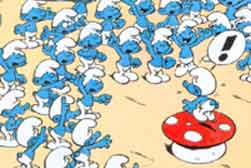Meet the "legal" drug pushers:
Frontline: Dangerous Prescription

Precisely because the prospects for further accelerating the approval process seem slim, the industry in the last few years has expended considerable lobbying efforts on other issues. Many of these efforts have taken place through PhRMA, Pharmaceutical Research and Manufacturers of America, one of Washington's most powerful trade groups. PhRMA is a well-financed, well-staffed operation: according to a report by Public Citizen, the liberal watchdog group, PhRMA alone employed 50 lobbyists in 2001. (The drug industry as a whole used more than 600 lobbyists that year, the report said.) But the reason drug lobbyists have had so much clout is that the pharmaceutical industry has spent a great deal of money financing political campaigns, devoting dramatically greater sums each year. According to the Center for Responsive Politics, the pharmaceutical industry spent $22 million on campaign contributions in 2002 -- or more than nine times what it did in 1990. Given that the industry spends untold millions more on advertising and other forms of issue-oriented public relations, it's no wonder Illinois Senator Dick Durbin, a Democrat, recently declared that PhRMA "has a death grip on Congress."
(snip)
Mindful of these figures, and the fact that millions of Americans have been struggling to pay for their expensive prescription drugs (see FRONTLINE's recent report "The Other Drug War"), industry critics in Congress such as Rep. Henry Waxman, a Democrat from California, tried in 2001 to renegotiate the arrangement. Under Waxman's proposal, instead of extending patents, the government would simply pay industry twice the cost of actually running the pediatric studies. But the drug lobby would have nothing of it. Warning that cuts in the financial incentive would leave the industry with little choice but to abandon pediatric testing, drug makers lobbied Congress to preserve the arrangement unaltered. It even hired two former congressional staffers, who had worked on the committees with jurisdiction over the legislation, to help make the case. The industry prevailed, and the law was renewed with no substantial changes.
Published on Thursday, December 2, 2004 by Inter Press Service
Vioxx Scandal Raises Global Doubts on U.S. Drug Safety
by Katherine Stapp
Read the full article here(RTFAH)
Since its approval in 1999, Vioxx has been used by two million people in more than 80 countries. Its manufacturer, the U.S. pharmaceutical giant Merck & Co, earned 2.5 billion dollars from the drug last year alone.
(snip)
The company voluntarily withdrew Vioxx on Sep. 30 after a study confirmed years of suspicions that the drug raises the risk of heart attack, stroke and death. The recall soon exposed serious flaws in the regulatory activities of the Food and Drug Administration (FDA), which stood behind Vioxx despite studies indicating the drug had dangerous side effects.
In congressional hearings last month, David Graham, an FDA drug safety reviewer, testified the agency downplayed mounting negative data on Vioxx, and that it ”seriously undervalues, disregards and disrespects drug safety” in general. He listed five other potentially dangerous medications currently on the market -- Accutane, Bextra, Crestor, Meridia and Serevent.
Looks like the "legal" drug dealers slipped up. Actually, the article as a whole is quite interesting, and worth the few minutes of eye time.
In Other News:
Published on Thursday, December 2, 2004 by Agence France Presse
Despite 25 Years of Drug War, US Prices are Down
RTFAH
WASHINGTON -- Cocaine and heroin are cheaper today on US streets, despite a multi-billion- dollar, 25-year drug war, according to the Washington Office on Latin America, citing data from the US drug czar.
"The demand for cocaine, crack and heroin is at least stable, if not rising," said John Walsh, an expert on the matter at WOLA, a Washington think-tank on Latin America.
(snip)
"After 25 years and 25 billion dollars fighting drugs in Latin America, we are no closer to winning the drug war -- which is ultimately about reducing drug abuse," said Joy Olson, executive director of WOLA, in a presentation of the 400-page report.
"We've spent billions on anti-drug efforts in Latin America and have nothing to show for it but collateral damage," Olson added. "We can do better. We've been tough on drugs; now it's time to get smarter."
Yes, smarter. Prohibition only increases criminal organization. Can we please learn something from history already?
Not to mention the fact that cars, guns, alcohol, tobacco, fast food can all kill if not approached responsibily. We can't fight "drugs", we might as well fight sex or entertainment. Drugs are older than history. Like anything else in society, the solution to the problem lies in the processes of enculturation, i.e. education and parental leadership.
Now, had we spent that $25 billion to improve the teacher-child ratio in public schools, perhaps we'd have fewer "abusers".
Then again, maybe they'd just abuse Cialis, Viagra, Adderall, Ritalin, etc...
meanwhile...
Supreme Court weighs marijuana as medicine
Attorneys for White House, women press their cases
RTFAH
Watching the argument was Angel Raich, an Oakland, California, mother of two who said she tried dozens of prescription medicines to ease the pain of a brain tumor and other illnesses before she turned to marijuana. She and another ill woman, Diane Monson, filed a lawsuit to protect their access to the drug after federal agents confiscated marijuana plants from Monson's yard.
(snip)
The justices refused three years ago to protect distributors of medical marijuana from federal charges. They are confronting a more personal issue this time -- the power of federal agents to go after sick people who use homegrown cannabis with their doctors' permission and their states' approval.
The stakes are high because 11 states have passed medical marijuana laws since 1996. A defeat for the two California women might undermine those laws and discourage other states from approving their own.
(snip)
The marijuana users won in the San Francisco-based 9th U.S. Circuit Court of Appeals, which ruled that federal prosecution of medical marijuana users is unconstitutional if the pot is not sold, transported across state lines or used for nonmedicinal purposes.
Justice Ruth Bader Ginsburg said the federal government has a stake in interstate commerce, but with the California medical marijuana patients: "Nobody's buying anything. Nobody's selling anything.
Her colleague, Justice Sandra Day O'Connor, observed that homegrown medical marijuana never makes it to the interstate market.
So, is there a "big picture" to all this?

















 the world is what we make it
the world is what we make it





















